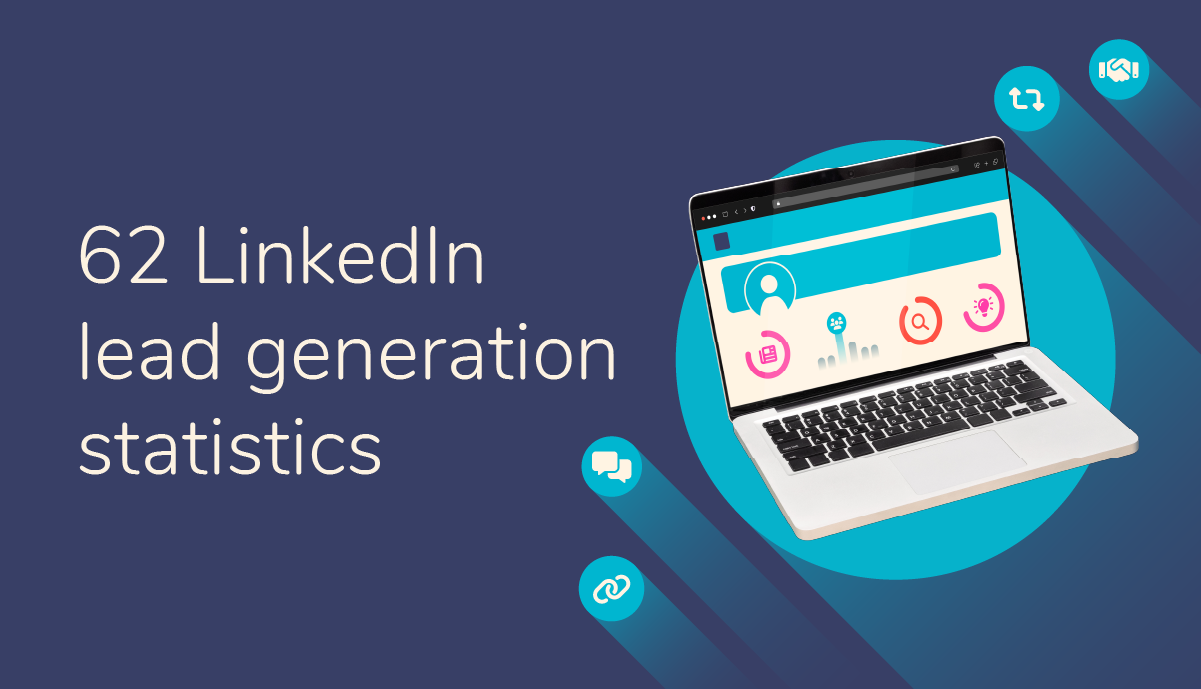B2B cost per lead benchmarks by channel and industry (2025 update)
Table of content
- Our top 10 B2B cost per lead insights for 2025
- Average cost per lead benchmarks by industry
- Cost per lead benchmarks by channel
- LinkedIn cost per lead benchmarks
- Facebook cost per lead benchmarks
- PPC cost per lead benchmarks
- SEO cost per lead benchmarks
- Direct mail cost per lead benchmarks
- Affiliate marketing cost per lead benchmarks
- Multi-channel prospecting cost per lead benchmarks
- Cross-channel analysis: Which channel has the lowest CPL?
- Cost per lead by business type and size
- B2B SaaS cost per lead: A deep dive
- What does a “good” cost per lead look like? (And why is that the wrong question to be asking?)
- How has the average cost per lead changed over the years?
- Looking forward: How are costs per lead set to change?
- Methodology and sources

Lead generation is never one-size-fits-all, and neither is its cost. As marketing budgets tighten and sales targets soar, understanding your cost per lead (CPL) isn’t just helpful, it’s essential.
From industry breakdowns and channel performance to company size, outsourcing comparisons, and predictions for what’s next, we’re unpacking it all.
As the saying goes, knowledge is power. So, whether you’re working with a B2B lead generation agency or managing campaigns in-house, use these CPL benchmarks to put the numbers into context.
Our top 10 B2B cost per lead insights for 2025
- Legal services is the most expensive industry for lead generation, with CPLs averaging $650. → Read more
- Software development leads are almost as pricey for leads, with typical CPL just under $600. → Read more
- B2B SaaS sit at the other end of the scale, with CPLs around $188. → Read more
- Unsurprisingly, trade shows and in-person events come with the highest CPL, at $840. → Read more
- Referrals and affiliate marketing are the most cost-effective ways to gather leads, with CPLs at just under $25 and $73, respectively.→ Read more
- Multi-channel prospecting is another cost-effective channel with an average CPL of $188. → Read more
- Businesses with fewer than 50 employees typically pay $146 per lead. → Read more
- Enterprise-level businesses pay more per lead, with CPLs rising to $429 for companies earning over $500 million annually. → Read more
- Large businesses could spend more on employing just two B2B sales reps than they would on outsourcing their lead generation tasks.→ Read more
- Average CPL has held steady since 2023, decreasing by just 0.23%.→ Read more
Average cost per lead benchmarks by industry
| Industry | Average cost per lead | Low cost per lead | High cost per lead |
| Legal Services | $650 | $516 | $784 |
| Software Development | $595 | $510 | $680 |
| IT & Managed Services | $501 | $385 | $617 |
| Staffing & Recruiting | $497 | $476 | $518 |
| Financial Services | $461 | $160 | $761 |
| Business Insurance | $424 | $388 | $460 |
| Manufacturing | $391 | $90 | $691 |
| Construction | $227 | $174 | $280 |
| B2B SaaS | $188 | $65 | $310 |
Cost per lead can vary wildly depending on the industry you’re in. In B2B, those differences are often tied to deal complexity, the sales cycle length, and a customer’s lifetime value.
For B2B leaders, these numbers shouldn’t just be a budget line item. They’re a reminder to zoom out. A higher CPL might feel like a red flag, but if your leads convert into long-term, high-value clients, that’s money well spent.
Our 2025 State of Prospecting report found that 42% of B2B companies cite lead quality as a top marketing challenge. The key is to track not just cost, but quality and conversion.
Financial services cost per lead benchmarks
Average CPL for financial services: $461
With an average CPL of $461 and a potential high cost of $761, financial services lead generation doesn’t come cheap. But considering the value of each converted customer and the compliance-heavy journey to win them, it’s easy to see why.
If you’re in this space, you’ll know you’re not just selling a product. You’re selling trust. That’s why channels with strong targeting and professional positioning, like LinkedIn and tailored email outreach, can deliver the best results. They may cost more up front, but they often lead to more qualified, sales-ready prospects.
We found that financial services is the most prospected industry (13.7% of emails), which is why many firms lean on a financial services lead generation agency to help navigate compliance while still hitting targets.
IT and software cost per lead benchmarks
Average CPL for IT and managed services: $501
Average CPL for software development: $595
IT and managed services have an average CPL of $501, while software development is a little higher at $595. This makes sense, as these are technical solutions where prospects need time and proof before committing.
Rather than chasing volume, B2B leaders in tech should double down on quality. That means thoughtful content, smart targeting, and channels that let you speak to specific pain points. These are all things an IT lead generation agency will know a thing or two about.
Recruitment and staffing cost per lead benchmarks
Average CPL for staffing and recruiting: $497
At an average of $497 per lead, ranging from $476 to $518, recruitment and staffing is another high-investment industry. But that’s not surprising. Finding the right talent takes more than just a click. It takes credibility, relevance, and a strong sense of timing.
This is where smart targeting and positioning matter. Many recruitment firms find that a staffing and recruitment lead generation agency helps them reach the right clients more consistently with insight-led content and personalised outreach.
It’s not about shouting louder. It’s about showing you understand their hiring pain points and can solve them.
Legal services cost per lead benchmarks
Average CPL for legal services: $650
The average CPL for legal services is $650, but it could go as high as $784, which puts it firmly in the premium bracket. That’s not just about ad costs; it’s about the stakes involved. Legal clients are often cautious, research-heavy, and risk-averse, and rightly so.
Legal marketers need to demonstrate credibility from the first touchpoint to stand out. That’s where content-led lead gen strategies shine. Educational emails, expert-led webinars, and clear, helpful landing pages can go a long way toward building trust.
Cost per lead benchmarks by channel
| Marketing channel | Average cost per lead | Low cost per lead | High cost per lead |
| Trade shows and in-person events | $840 | $180 | $1,500+ |
| PPC | $463 | $175 | $751 |
| Paid LinkedIn advertising | $408 | $15 | $800+ |
| Cold calling | $300 | – | – |
| Webinars | $267 | $33 | $500 |
| Direct mail | $250 | – | – |
| Cold emails | $225 | $150 | $300 |
| SEO | $206 | $14 | $397 |
| Multi-channel prospecting | $188 | $80 | $296 |
| Paid Facebook advertising | $142 | $102 | $182 |
| Affiliate marketing | $73 | $54 | $92 |
| Referrals | $25 | – | – |
Channel choice significantly impacts CPL, and it’s not always as simple as cheapest is best. Trade shows and events are the highest-cost channels, at $840, but they often deliver unmatched relationship-building opportunities. Despite the high cost, 12.3% of companies plan to increase marketing spend for events in 2025.
But what about other channels? Let’s take a look.
LinkedIn cost per lead benchmarks
Average CPL for paid LinkedIn advertising: $408
LinkedIn ads average $408 per lead, with some B2B companies paying $800 or more. That might raise eyebrows, but context is everything. LinkedIn gives you access to decision-makers, job titles, and industry segments you can’t find anywhere else.
Learn more about LinkedIn lead generation.
Facebook cost per lead benchmarks
Average CPL for Facebook ads: $142
With a CPL of $142, Facebook ads are one of the more affordable options after affiliate marketing and referrals. That’s ideal for brand awareness and top-of-funnel activity, but it comes with a caveat.
Not every Facebook lead is sales-ready. The average return on assets (ROA) is 29%, lower than Google Ads (78%) and paid LinkedIn advertising (113%).
PPC cost per lead benchmarks
Average CPL for PPC ads: $463
Done well, PPC offers both reach and control. But costs can climb quickly without tight targeting, compelling ad copy, and strong landing page performance. For B2B leaders, the goal is relevance. Target fewer, but better, leads and optimise for conversions, not just clicks.
SEO cost per lead benchmarks
Average CPL for SEO: $206
At $206 per lead, SEO is one of the more cost-effective channels available. It’s a longer play, but the payoff is consistent, with high-intent traffic and relatively low ongoing cost.
The key is to invest in quality. That means strategic content, technical optimisation, and a user-friendly website. Building authority may take time, but once you do, the leads tend to be warmer, more informed, and more likely to convert.
Direct mail cost per lead benchmarks
Average CPL for direct mail: $250
With an average CPL of $250, direct mail sits at the higher end of the spectrum. But in a digital-saturated world, that physical touchpoint can truly stand out. Over one in six (17%) buyers prefer to hear from sellers over post/direct mail.
This tactic isn’t for everyone. You need to target a small, high-value list, such as enterprise buyers or C-suite contacts. Direct mail can feel more personal and memorable.
Affiliate marketing cost per lead benchmarks
Average CPL for affiliate marketing: $73
Affiliate marketing averages $73 per lead, making it a mid-range channel in terms of CPL. It’s performance-based, which appeals to many B2B marketers who want predictable returns.
The real challenge is partner quality. Success depends on selecting affiliates who genuinely understand your audience and can represent your brand with authority. When the fit is right, affiliate channels can become a consistent, cost-effective source of leads.
Multi-channel prospecting cost per lead benchmarks
CPL for multi-channel prospecting: $188
Blending marketing channels doesn’t mean adding the cost per lead of email, cold calling, social media or direct mail together. But it can combine the results they get.
Most businesses spend an average of $188 per lead on multi-channel prospecting, making it at the cheaper end of the scale already. But better than that, Sopro clients pay an average of just $134. That’s because our campaigns are designed and managed by experts, using live data and proven technology to run and optimise outreach across every channel.
Cross-channel analysis: Which channel has the lowest CPL?
If we go by numbers alone, referrals win the low-cost crown at $25 per lead. Affiliate marketing follows at $73, and paid Facebook advertising comes in at $142. But low CPL doesn’t always equal high ROI.
Lead quality matters as much, if not more, than lead cost. Cheaper platforms can drive volume, but often require more nurturing. Channels like LinkedIn or PPC may cost more, but deliver leads further in the buying process.
The smartest strategy is to blend channels. Use low-cost platforms for awareness and invest more heavily where the best leads live.
Data from our State of Prospecting 2025 report shows that businesses running multi-channel campaigns see a 31% uplift in leads compared to single-channel campaigns. These campaigns also perform best when managed by a B2B multi-channel marketing agency that can coordinate strategy across platforms.
Cost per lead by business type and size
| Company size | Average cost per lead |
| 1,000+ employees | $348 |
| 201-1,000 employees | $212 |
| 51-200 employees | $180 |
| 2-50 employees | $146 |
| Business revenue | Average cost per lead |
| $500+ million | $429 |
| $10-500 million | $179 |
| $1-10 million | $184 |
| <$1 million | $166 |
Enterprise business cost per lead benchmarks
As company size increases, so does the cost per lead. Enterprise-level businesses with over 1,000 employees typically spend around $348 per lead, while mid-sized companies with 201 to 1,000 employees average $212.
The trend continues with revenue. Businesses earning between $10 and $500 million see an average CPL of $179. For those bringing in more than $500 million, that figure jumps to $429. At this level, you’re rarely looking for a quick sale. You’re nurturing strategic partnerships.
If your CPL looks dramatically different from these, don’t worry. It may not necessarily be down to something you’re doing wrong. But partnering with a lead generation agency for enterprise businesses can ensure you get the most for your money.
SME cost per lead benchmarks
The cost per lead tends to be more manageable for smaller businesses. Companies with up to 200 employees typically see CPLs between $146 and $180. That sweet spot allows SMEs to test and iterate without blowing the budget.
Revenue tells a similar story. Businesses earning under $1 million have an average CPL of $166, which rises slightly to $184 for companies earning up to $10 million.
Outsourced vs internal lead generation costs
Outsourcing your lead generation can feel like a significant investment, but compared to building a whole in-house team, it’s often more cost-effective. Especially when an SME lead generation agency can deliver a full stack of talent for only $2,000 to $5,000 a month. Medium-sized companies might invest $5,000 to $10,000, while large businesses could see costs exceeding $10,000 monthly.
Now compare that with hiring even two B2B sales reps, with an average salary of $76,000 per year, or $6,333 a month. Factor in bonuses, tech, data tools, and training, and the cost quickly increases. Sopro research for the 2025 Outbound Pulse Survey found that the average B2B company’s typical monthly budget for outbound sales outreach is $19,265, meaning outsourcing can realistically help many brands save significantly on budget.
It’s not all about the cash, either, but about the final product. Outsourcing gives you access to seasoned experts, proven systems, and campaign momentum from day one without the long ramp-up time.
B2B SaaS cost per lead: A deep dive
If you work in B2B SaaS, you already know that lead generation isn’t the cheapest.
The average cost per lead through paid channels is $310. Organic leads cost significantly less, at $164. Blend the two, and your average CPL lands around $237.
Those figures seem steep on the surface. However, SaaS businesses typically enjoy long customer lifecycles, recurring revenue, and expansion opportunities.
Want to know more? Explore B2B SaaS lead generation services in full.
What does a “good” cost per lead look like? (And why is that the wrong question to be asking?)
Let’s be honest: asking what a “good” CPL looks like is a bit like asking how long a piece of string is. The answer? It depends. On your industry, your audience, your offering, or even how you define a lead in the first place.
Simply put, a “good” cost per lead means your acquisition cost is significantly lower than the revenue that the lead will generate.
But not all leads are created equal.
Every business and every CPL study will count different things as a lead. Consider a content download, a business card at an event, a positive reply to a sales prospecting email, and a demo request. Are those all equal value, and do they count towards calculating your CPL?
There’s no shortage of variables that influence CPL. Some are in your control. Others? Not so much. Here are the big ones:
Industry
Simply put, some industries are more competitive, increasing the cost per lead. Consider increased competition when bidding on PPC keywords or more companies vying for attention in the inbox.
Target audience
Who you target can have a significant impact – it can be harder to find and connect with a niche market than a broader audience, and established companies may have bigger budgets than startups.
Geography
If you sell in multiple locations, you’ll find that different markets are more cost-effective. This can be down to varying levels of competition, the size of the market, or local economics.
Marketing strategy and team performance
Regardless of channel, how well your team plans and executes good marketing campaigns will affect costs. Don’t fire them because I said that, though.
Competitors
The level of competition will significantly impact whether these cost-per-lead benchmarks align with your efforts. More competition equals increased costs.
Product or service
The product or service you sell can significantly impact marketing costs. If your product’s price is high and your customers’ lifetime value is high, you can afford to spend more on marketing before it becomes unviable.
None of these factors exists in isolation. The trick is understanding your landscape, controlling what you can, and adapting the rest.
How has the average cost per lead changed over the years?
If you expect dramatic CPL shifts over the past year, the numbers might surprise you. From 2023 to 2024/25, the changes have been marginal at best.
| Year | Average cost per lead (paid) | Average cost per lead (organic) | Average cost per lead (blended) |
| 2023 | $562.11 | $403.11 | $482.67 |
| 2024/25 | $562.11 | $402.78 | $481.56 |
| YoY change | 0.00% | -0.08% | -0.23% |
Yes, you read that right, blended CPL has reduced by a fractional percentage, with the cost of paid CPL remaining steady and organic by 0.08%. That stability is good news for B2B marketers. Despite rising ad costs in some channels and ongoing shifts in buyer behaviour, average CPL has held steady.
But don’t take that as a reason to stand still. Beneath those averages lie plenty of micro-shifts: changes by sector, shifts in channel effectiveness, and evolving expectations from your target audience. The businesses that continuously test, refine, and optimise are the ones that keep CPL in check and results on track.
Looking forward: How are costs per lead set to change?
Forecasting CPL isn’t about a crystal ball. It’s about reading the signals. And right now, the outlook is mixed.
Increased automation and AI-driven tools are helping teams work smarter, streamline targeting, and deliver more efficient campaigns. In the long run, this should keep CPL under control.
While recent data points to a (tiny) decrease in CPL, don’t be fooled. The future of costs per lead could be turbulent.
Competition isn’t slowing down. More businesses are investing in digital, more ads are flooding the same channels, and privacy changes are making precise targeting trickier. As competition intensifies, partnering with a trusted B2B demand generation agency can help you stay ahead.
Expert Q&A on cost per lead benchmarks
How is B2B cost per lead calculated?
Calculating your cost per lead uses a simple formula. Take the total amount you spend on marketing and business development, divide it by the number of leads you won during that period, and voilà: you have your figure.
But remember: that figure only tells part of the story. A low CPL might look great on a spreadsheet, but it won’t mean much if those leads never convert. Always measure cost alongside quality.
Why does CPL vary so much between industries and marketing methods?
Some industries are just more crowded. If you’re in marketing, law, or SaaS, you’re probably bidding on popular keywords, emailing decision-makers who get dozens of pitches a week, and generally fighting harder to be heard. That drives up costs.
Your chosen channels play a role too. SEO takes time, but often delivers a lower CPL. Google Ads might get you faster results, but at a steeper price.
And then there’s your team. A brilliant campaign will naturally drive better results for less.
Why do some industries see more fluctuation in CPL over time?
Some sectors are more sensitive to external shifts. Think of industries tied to regulation, fast-moving tech, or seasonal demand. When the market changes (whether it’s legislation, a new competitor, or budget season), so does your CPL.
Add algorithm updates, evolving buyer behaviour, and economic turbulence, and you have a recipe for regular changes. The most resilient teams keep testing, tracking, and tweaking to stay ahead.
How does customer lifetime value affect acceptable CPL ranges?
In short: the more a customer is worth to your business, the more you can afford to spend bringing them in.
If you’re selling a $20 monthly subscription with high churn, you’ll need to keep your CPL low to turn a profit. But if your average customer sticks around for years and brings in six figures? Suddenly, a $500 CPL looks like a wise investment.
How can businesses anticipate and adapt to seasonal CPL fluctuations?
You’ve probably seen it already. CPL creeps up in Q4 when budgets are tight or competition spikes before key buying seasons. Slows down in summer when decision-makers are on holiday. Peaks again when everyone returns with refreshed targets.
The smartest approach is to build seasonality into your strategy. Look at last year’s data, anticipate shifts, and adjust your campaigns accordingly. If you know Q1 is typically more competitive, for example, front-load your budget for Q2, when CPLs are likely to dip.
CPL may never be static, but with the proper planning, it doesn’t have to catch you off guard.
Methodology and sources
Sopro conducted proprietary research for the State of Prospecting 2025 report. Insights and findings related to cost per lead benchmarks have been compiled with data from other sources to form a complete collection.
FirstPageSage – Average Cost Per Lead by Industry – 2025
Revnew – What Impacts Lead Gen Costs? A Guide for Businesses in 2025
LeadSpot – How Much Do B2B Leads Cost in 2025? Benchmarks by Channel, Industry, and Funnel Stage
VistorQueue – What is the Average Cost Per Lead for Different Marketing Channels in 2025?
Tamarind’s B2B House – Linkedin Ad Benchmarks 2025 – An Always Up-to-date Guide
Book Your Data – Cost Per Lead Breakdown: How to Calculate and Benchmark Your CPL
Dreamdata – B2B Google Ads Benchmarks 2024
metadata.io – Head to Head comparison of the performance of the major paid social channels
The New Workforce – How Much Does it Cost to Outsource Lead Generation?








Share